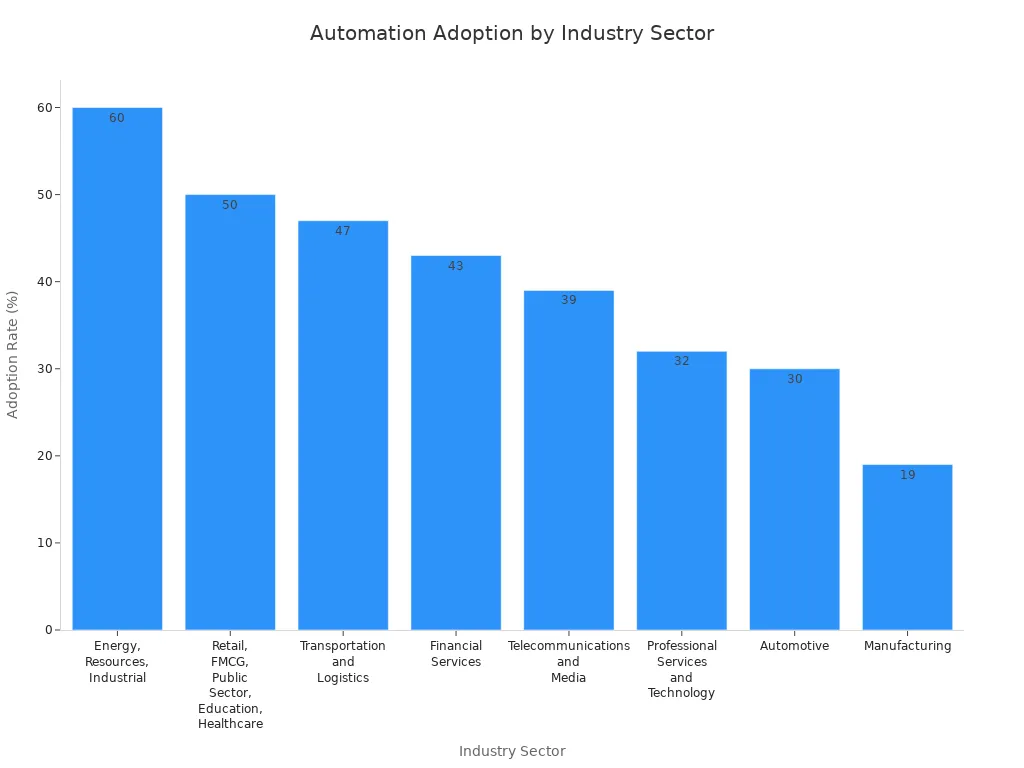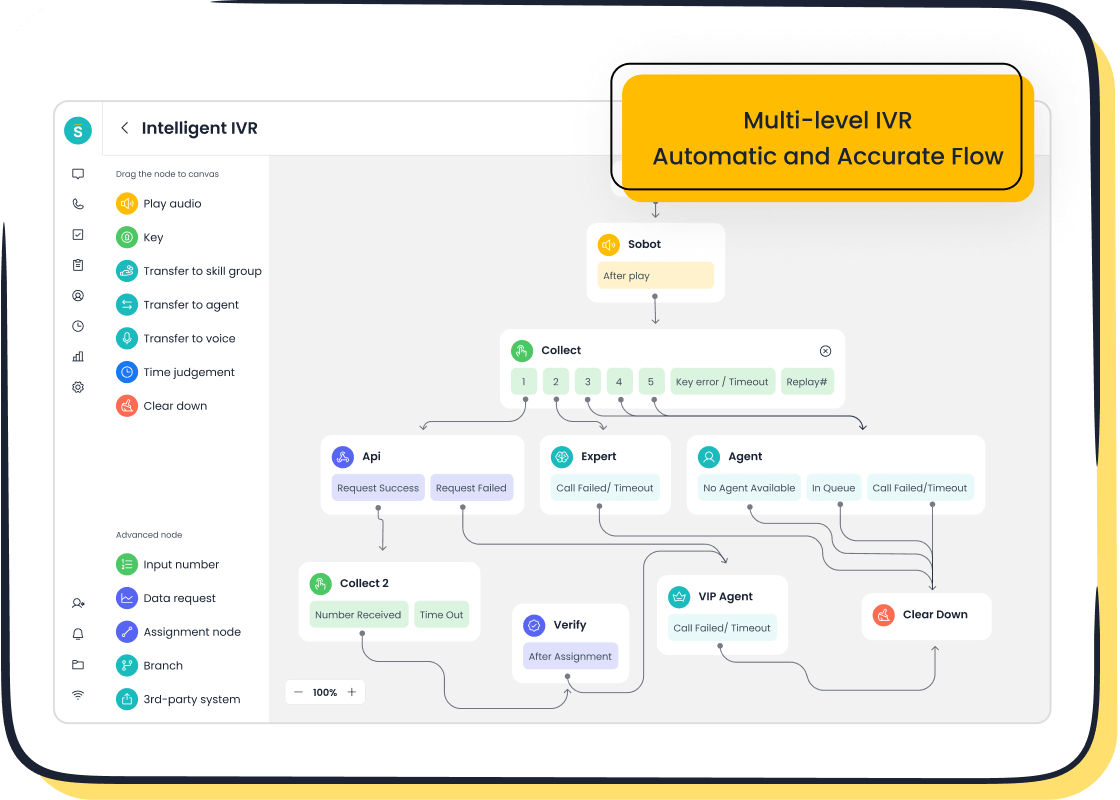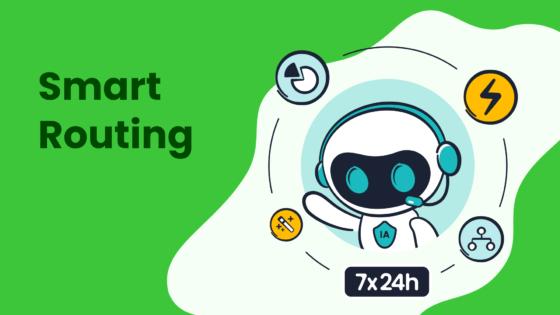Automated Contact Center Definition and Working Process

An automated contact center uses technology like artificial intelligence and workflow automation to manage customer interactions without heavy reliance on human agents. Many businesses now choose automated customer service to boost efficiency and improve customer satisfaction. In the past five years, industries such as energy and retail have seen up to 60% adoption rates for automation in contact centers.

Automated contact center solutions, like those from Sobot AI, help companies reduce wait times and handle repetitive tasks. Sobot call center technology supports global customers and offers reliable service. Reports show that automation leads to faster responses and higher customer satisfaction scores. Sobot provides advanced tools that improve customer experiences and make automated contact center operations more effective.
Automated Contact Center Basics

What Is an Automated Contact Center
An automated contact center uses advanced technology to manage customer interactions across many channels. Companies rely on contact center automation to improve efficiency and deliver better service. Automated call centers use artificial intelligence, machine learning, and robotic process automation to handle tasks that once needed human agents. These systems can answer questions, route calls, and even analyze customer emotions.
Key components of an automated contact center include:
- Sentiment analysis and natural language processing (NLP) to understand what customers feel and need.
- Computer Telephony Integration (CTI) that connects phone systems with computer applications for smooth call handling.
- Quality management software that checks agent performance and ensures compliance.
- Analytics and reporting tools that track how well the contact center performs.
- Knowledge management systems that store company information for agents to use.
- Automation software that brings together tools like IVR, chatbots, automatic call distribution, and workforce management.
Automated call centers use AI-powered chatbots and virtual assistants to answer common questions. These bots can direct more complex issues to human agents. Interactive Voice Response (IVR) and voicebots let customers use self-service options, saving time for both the customer and the business. Robotic Process Automation (RPA) handles repetitive tasks like data entry, so agents can focus on helping customers with unique problems.
Contact center automation also includes omnichannel management. This means customers can reach out by phone, email, chat, social media, or messaging apps, and the system keeps all their information in one place. Integration with CRM and unified communication platforms helps agents see a complete view of each customer, making service more personal and efficient.
Cloud-based automated call centers offer flexibility and scalability. Companies can add or remove agents as needed, and remote teams can work from anywhere. Real-time analytics and speech analysis help managers monitor calls and coach agents to improve service. Predictive AI can even spot customer needs before they become problems, allowing proactive support.

Sobot provides a strong example of these features in action. Its cloud-based call center solution includes AI-powered voicebots, drag-and-drop IVR, and a unified workspace for agents. Sobot’s platform supports global telephony, integrates with CRM systems, and offers real-time analytics. These tools help businesses deliver fast, accurate, and consistent service to customers around the world. Sobot’s system stability reaches 99.99%, ensuring reliable operations for companies of all sizes. Learn more about Sobot’s Voice/Call Center.
Tip: Automated call centers can improve customer satisfaction by providing 24/7 service and reducing wait times.
Automated vs. Traditional Call Center
Automated call centers and traditional call centers differ in many ways. Traditional call centers focus mainly on voice calls. They use telephony networks, Automatic Call Distribution (ACD), and basic IVR systems. These centers often struggle with long wait times, limited communication channels, and inconsistent service.
Automated call centers use contact center automation to solve these problems. They handle routine tasks with AI, machine learning, and smart routing. This reduces human error and allows for 24/7 customer support. Automated call centers can process calls faster, lower wait times, and improve first-call resolution rates. Companies save money by reducing the need for extra staff, training, and supervision.
Here is a comparison table to show the main differences:
| Feature | Traditional Call Center | Automated Call Center |
|---|---|---|
| Main Channel | Voice calls only | Omnichannel (voice, chat, email, etc.) |
| Technology | Telephony, ACD, basic IVR | AI, machine learning, RPA, advanced IVR |
| Automation Level | Low | High |
| Cost | High (staff, infrastructure) | Lower (cloud, AI, less staff) |
| Scalability | Limited | Flexible, cloud-based |
| Analytics | Basic | Real-time, advanced |
| Customer Experience | Inconsistent, slower | Fast, consistent, 24/7 |
| Integration | Siloed systems | Unified CRM, omnichannel |
Automated call centers use AI to automate 100% of call routing, which minimizes delays and improves first-call resolution. Real-time dashboards help managers spot inefficiencies and optimize workflows. For example, a retailer that switched to a cloud-based automated contact center saw first-call resolution improve to 85% and average handle time drop by 34 seconds. This change saved the company $675,000 in one year. Automation also reduced customer service costs by up to 30%. Blending human and bot interactions improved customer satisfaction by 61% and agent satisfaction by 69%.
Cost differences between automated and traditional call centers are significant. Traditional centers need more managers and supervisors, which adds 7-15% to costs. AI platforms reduce or remove these overheads. Per-call costs drop by 65-82% with AI voice agents. Traditional centers spend 15-30% more on facilities and equipment, while automated call centers use cloud environments with minimal infrastructure expenses. AI call centers often use consumption-based pricing, which is much lower than the hourly or per-call rates of traditional centers.
AI virtual assistants in automated call centers can reduce average handle time by 20-50%. Quality assurance costs drop by 40% through automation. Cloud-based AI systems save 15-40% on infrastructure compared to traditional setups. Industry forecasts predict that by 2026, AI will handle 30% of interactions at less than 25% of traditional costs.
Sobot’s omnichannel solution shows how contact center automation can unify customer interactions across phone, chat, email, and social media. Sobot’s platform automates repetitive tasks, provides a unified workspace, and delivers real-time analytics. This helps businesses improve productivity by 30% and increase customer satisfaction. Explore Sobot’s Omnichannel Solution.
Note: Automated call centers scale easily during busy periods without hiring extra staff. This flexibility helps companies manage costs and maintain high service levels.
Automated contact centers represent the future of customer service automation. They combine advanced technology, flexible operations, and data-driven insights to deliver better outcomes for both businesses and customers.
Contact Center Automation Technologies
AI and Chatbots
AI and chatbots have become essential in contact center automation. These virtual agents use natural language processing to understand customer questions and provide instant answers. Automated call centers rely on AI tools to manage large volumes of customer interactions. Chatbots resolve common issues like password resets, billing inquiries, and account updates without human help. This process improves first-contact resolution rates and reduces wait times.
A recent study found that AI-powered chatbots can handle up to 80% of routine customer requests. They work around the clock, offering self-service options that let customers solve problems any time. When a chatbot cannot resolve an issue, it passes the case to a human agent with all relevant information. This handoff speeds up resolution and keeps customers satisfied.
Sobot’s AI-powered Voice/Call Center uses advanced chatbots to support global businesses. The platform combines AI with a unified workspace, allowing agents to see customer data and chat history in one place. Sobot’s chatbots provide accurate, multilingual responses and escalate complex cases to human agents. This approach increases efficiency and improves customer satisfaction.
Here is a table showing some widely used AI and chatbot platforms in automated call centers:
| Platform | Core Features & Capabilities | Integration & Unique Functionalities |
|---|---|---|
| Call KarmaAI | AI-powered contact center automation | N/A |
| RingCentral CustomGPT.ai | Custom generative AI chatbots for contact centers | Deep CRM integration, real-time conversation intelligence |
| Cognigy.AI | No-code chatbot building, complex workflow automation | Supports multi-channel communication |
| Forethought | Generative AI for helpdesk operations | AI-driven ticketing and knowledge management |
| Replicant | Conversational voice AI | Automates voice interactions with customers |
| Google Contact Center AI | Virtual agents for handling basic questions, Agent Assist for human support | Integrates with Google Dialogflow, major communication providers, CRM integration, analytics |
| IBM watsonx Assistant | Virtual AI support with customizable dialog flows | Integrates with popular CRM and contact center platforms |
| Dialpad AI | Integrated AI contact center tool with call transcription | Provides call sentiment trends, call volume analytics |
| Microsoft Azure AI Services | Speech-to-text, text-to-speech, generative AI models and bots | Modular purchase options for flexible solution design |
AI tools in automated call centers help companies reduce costs and improve service quality. Sobot’s chatbots use generative AI to compose industry-specific responses, making customer interactions more professional. These automated solutions support self-service and customer interaction automation, freeing agents to focus on complex tasks.
Tip: AI-powered chatbots in contact center automation can boost first-contact resolution rates by instantly solving common problems and escalating complex cases to human agents.
IVR and Voicebots
Interactive Voice Response (IVR) and voicebots play a key role in call center automation. IVR systems guide customers through menus using voice or keypad inputs. Automated call centers use IVR to route calls, provide self-service options, and handle multiple calls at once. Voicebots use AI to understand natural language and answer questions, making customer service automation more efficient.
Automated call centers benefit from IVR and voicebots in several ways:
- Skills-based routing sends customers to agents with the right expertise, reducing call transfers.
- AI-powered voicebots handle basic requests and FAQs, lowering agent workload.
- Voicebots escalate complex issues to human agents, ensuring efficient use of agent time.
- IVR systems manage many calls at once, preventing agent overload.
- 24/7 availability lets customers access services anytime, reducing peak call loads.
- Accurate call routing helps customers reach the right agent quickly.
- Self-service options empower customers to solve simple problems without agent help.
- AI-enhanced FAQs and chatbots provide real-time answers and escalate only when needed.
- Automating routine tasks with AI chatbots reduces call volume and allows agents to focus on complex issues.
A global healthcare organization used conversational IVR to improve call routing and troubleshooting. This change reduced average handling time and increased operational efficiency. Automated call centers with IVR and voicebots offer self-service, which helps customers resolve issues faster and lowers costs.
Sobot’s Voice/Call Center solution features intelligent IVR and AI-powered voicebots. The platform supports global telephony, drag-and-drop IVR menus, and smart call routing. Sobot’s voicebots interact with customers in multiple languages and recognize intent, providing accurate responses. These automated solutions streamline customer interaction automation and improve call center performance.
Note: IVR and voicebots in call center automation reduce average handling time by automating simple interactions and routing calls efficiently.
Integration and Omnichannel Support
Integration and omnichannel support are vital for contact center automation. Automated call centers connect multiple communication channels, such as phone, email, chat, social media, and messaging apps. This unified approach gives agents a complete view of each customer’s journey, improving service quality and personalization.
Omnichannel support in automated call centers offers several benefits:
- Higher first-call resolution rates through intelligent call routing.
- Greater operational efficiency and cost savings by automating routine tasks.
- Competitive advantage and stronger brand loyalty with fast, consistent service across all channels.
- Unified customer interaction management for a single view of customer journeys.
- AI-powered quality assurance and sentiment analysis to improve agent performance.
- Seamless integration with CRM and marketing tools to enhance contact center capabilities.
- Real-time sharing of insights and automatic topic detection to identify trends.
- Workforce management with 100% interaction scoring for accurate agent evaluation.
- In-depth analytics to improve first call resolution and reduce wait times.
- AI capabilities that link customer data across channels and provide real-time agent guidance.
- Advanced AI Experience Agents that personalize interactions and anticipate customer needs.
Automated call centers use integration to connect with CRM systems, ticketing platforms, and business tools. This process supports customer interaction automation and self-service options. Sobot’s Omnichannel Solution unifies communication channels, including websites, mobile apps, social platforms, email, phone, and SMS. The platform uses AI to provide accurate, human-like responses and supports agents with reply suggestions and summaries.
Here is a table showing how Sobot’s AI-powered Voice/Call Center enhances omnichannel customer service:
| Feature Aspect | Description |
|---|---|
| Omnichannel Integration | Unifies communication channels including websites, mobile apps, social platforms, email, phone calls, and SMS into a single AI platform, enabling seamless customer interactions across channels. |
| AI Voicebot Capability | Handles both inbound and outbound calls, extending omnichannel reach beyond text-based channels. |
| Multi-Faceted AI Support | Supports customers with accurate, human-like responses; assists human agents by suggesting replies and drafting summaries; provides administrators with dashboards for operational optimization. |
| Generative AI Power | Utilizes advanced large and small language models to compose accurate, industry-specific responses, enhancing service quality and professionalism. |
| Data Privacy & Security | Ensures compliance with global data privacy regulations and holds international security certifications, with regional data centers for reliable worldwide performance. |
Sobot’s platform provides real-time analytics and dashboards for administrators. These AI tools help optimize team performance and improve customer satisfaction. Automated call centers with omnichannel support deliver consistent, proactive service and increase customer loyalty.
Callout: Omnichannel integration in contact center automation allows customers to reach out through their preferred channels, improving engagement and satisfaction.
Automated contact center solutions like Sobot’s offer scalable, secure, and efficient customer service automation. Companies using these automated solutions see higher first-call resolution rates, reduced costs, and better customer experiences. Automated call centers adapt to rising demand and new channels, supporting businesses of all sizes.
Key Features of Automated Call Centers
Workflow Automation
Automated call centers rely on workflow automation to streamline daily operations. These platforms use low-code or no-code tools, making it easy for teams to connect customer data across systems. Real-time data integration links CRM, billing, and other platforms, allowing agents to access information quickly. Multi-event triggers automate coordinated workflows, so agents receive notifications when tasks need attention. Omnichannel orchestration reaches customers through SMS, email, and digital outreach, supporting proactive engagement. Task automation reduces manual work, boosting agent productivity and minimizing errors. SLA compliance monitoring sends automated alerts to prevent violations. Pre-built integrations with over 50 business applications help connect systems efficiently. These automated processes allow agents to focus on complex customer issues, improving both productivity and customer satisfaction.
Workflow automation in call center automation reduces agent workload and streamlines operations, leading to faster support and higher customer satisfaction.
Smart Routing and Analytics
Intelligent call routing is a core feature of automated call centers. The system collects customer data, including account details and past interactions, to understand each inquiry. Business rules consider agent skills, availability, and customer preferences, matching calls to the best agent. This process reduces wait times and call transfers, increasing first-contact resolution rates. The table below shows how different routing types impact customer experience:
| Routing Type | Description | Impact on Customer Experience |
|---|---|---|
| Sentiment Analysis | Detects customer emotions and prioritizes frustrated customers. | Reduces escalation and improves satisfaction. |
| Skill-Based Routing | Matches inquiries to agents with the right expertise. | Increases resolution and personalized support. |
| Qualification Routing | Considers language, availability, and preferences. | Ensures efficient, familiar interactions. |
| Prioritization Routing | Assigns urgency and value-based priority. | Handles critical issues promptly, enhancing loyalty. |
| Omnichannel Routing | Routes queries across multiple channels. | Provides seamless engagement and consistent support. |
Real-time analytics support decision-making in automated call centers. Dashboards display key performance indicators like first-call resolution and average handle times. Automated alerts trigger actions when thresholds are met, such as adding agents during busy periods. AI-powered sentiment analysis and next-best-action recommendations help agents adjust their approach. Studies show that contact centers using real-time analytics can reduce average handle times by 10-15% and increase customer satisfaction scores by 5-10% (source).
Unified Workspace
A unified workspace brings all customer interaction channels and tools into a single interface. Agents see real-time communications, customer data, and workflows together, reducing errors and frustration. This setup shortens handle time and improves customer experience by providing fast, precise solutions. Centralized workspaces lower IT costs and allow agents to manage schedules, shifts, and evaluations efficiently. Sobot’s unified workspace uses AI-powered features to triple agent productivity through composition and summarization. Administrators benefit from AI insights that optimize workflows and track performance. The Ticketing System in Sobot’s platform enhances collaboration, making teamwork more connected and consistent. Agents can work flexibly from any device or location, supporting remote teams and improving engagement.
A unified workspace in automated call centers enables agents to deliver faster, personalized support, improving both agent productivity and customer satisfaction.
Benefits and Challenges

Customer Experience
Contact center automation brings measurable improvements to customer experience. Companies see higher customer satisfaction scores, faster issue resolution, and more personalized service. Automated call center solutions use AI-powered chatbots and self-service options to answer common questions, reducing wait times and improving first-contact resolution rates. Customers enjoy seamless omnichannel experiences, moving easily between phone, chat, email, and social media. For example, Sobot helped OPPO achieve an 83% chatbot resolution rate and a 94% positive feedback rate. These results show how automation can lead to stronger customer loyalty and proactive service. Automated call centers also provide smooth handoffs between AI and human agents, ensuring customers always get the help they need.
Companies report a 14% increase in agent productivity and a noticeable drop in average handle time after adopting call center automation.
Efficiency and Cost
Call center automation reduces operational costs by automating routine tasks and streamlining workflows. Organizations save money by handling basic inquiries with AI, which lowers the need for extra staff. Gartner predicts that conversational AI will cut contact center costs by $80 billion by 2026 (source). Sobot’s platform demonstrates these benefits by consolidating communication channels and automating call routing, which leads to reduced operational costs and improved agent productivity. Companies also see higher first-call resolution rates and lower call abandonment, which further boosts efficiency. Automation allows agents to focus on complex issues, making customer support more effective.
Balancing Automation and Human Touch
While automation improves efficiency, companies must balance it with human empathy. Human-AI hybrid models work best, letting AI handle routine tasks and agents manage sensitive or complex cases. Sobot’s solutions provide clear escalation paths, so customers receive personalized service when needed. Training agents to work with AI tools ensures smooth transitions and maintains high customer satisfaction scores. OPPO’s experience with Sobot shows that automation can scale support and deliver enhanced customer experience, but ongoing optimization and agent involvement remain important. Companies that combine automation with a human touch achieve better customer experiences, increased loyalty, and reduced operational costs.
Implementing Call Center Automation
Steps to Get Started
Organizations begin call center automation by mapping the customer journey. This step helps identify where automation can improve service and efficiency. Next, they select software that matches business needs, focusing on features like forecasting, auto dialers, chatbots, and customizable workflows. Sobot offers a flexible SDK and robust APIs, making integration with CRM and other business tools simple. Teams optimize their internal knowledge base to support automated responses. Live agents remain involved, with easy escalation options from IVR or chatbots. Omnichannel support reduces call volumes and gives customers more self-service choices. Continuous review of analytics and feedback refines call center automation over time.
Typical steps for successful implementation:
- Map customer journeys and pinpoint automation opportunities.
- Choose call center automation software with strong integration capabilities.
- Connect CRM, helpdesk, and sales platforms for unified data.
- Keep knowledge bases accurate and organized.
- Set up escalation paths for live agent support.
- Enable omnichannel engagement.
- Monitor analytics and customer feedback for ongoing improvement.
Sobot’s visual bot builder and intelligent routing help organizations deploy automation quickly and efficiently.
Best Practices
Effective call center automation depends on strong training and change management. Organizations use data-driven insights to personalize agent feedback. Cross-training and microtraining broaden agent skills. Gamification boosts engagement with challenges and rewards. Soft skills training improves communication and empathy. Hybrid training approaches, including virtual and in-person sessions, support remote agents. Clear objectives and KPIs guide progress. Leaders communicate openly about changes and benefits, reducing resistance. Gradual implementation and a dedicated change management team ensure smooth transitions. Continuous evaluation of training and feedback helps organizations adapt and improve.
Foster a positive training culture and encourage collaboration for lasting success in contact center automation.
Measuring Success
Organizations measure call center automation success using key performance indicators. The table below highlights important metrics:
| KPI Name | Description | Why It Matters |
|---|---|---|
| Automated Contact Resolution Rate | Percentage of issues resolved by automation | Shows effectiveness of automated systems |
| Average Speed of Answer by AI Systems | How fast AI responds to customer inquiries | Reflects efficiency |
| Call Routing Accuracy | Precision in directing customer queries | Impacts satisfaction |
| Chatbot Conversation Success Rate | Rate of successful chatbot interactions | Measures quality |
| Customer Satisfaction with Automated Services | Customer ratings of automated support | Indicates experience quality |
| First-Contact Resolution Rate | Issues solved in first automated interaction | Highlights prompt problem-solving |
Continuous improvement relies on monitoring these KPIs, retraining AI models, and collecting customer feedback. Sobot’s analytics dashboard helps organizations track performance and refine call center automation for better results.
Automated contact centers use AI and workflow automation to improve service and efficiency. Sobot’s solutions show strong results:
- AI chatbot deployment reduces customer service costs by 30%.
- Ticket resolution becomes 90% faster, boosting operational efficiency.
- Automation lets agents focus on complex tasks, increasing productivity.
- Personalized interactions and predictive analytics enhance customer experience.
- Companies see a 30% rise in customer loyalty.
Businesses can start their automation journey by exploring trusted providers like Sobot. For more details, visit Sobot’s official website.
FAQ
What is the main benefit of using automation in a call center?
Automation helps companies reduce wait times and handle more customer requests. For example, Sobot’s AI-powered solutions can answer common questions instantly. This leads to faster support and higher customer satisfaction scores.
How does intelligent call routing improve customer experience?
Intelligent call routing matches each customer with the right agent based on skills and needs. This process reduces transfers and wait times. Companies see improved first-contact resolution rates and better overall customer experience.
Can automated solutions lower operational costs?
Yes. Automated processes handle routine tasks, so companies need fewer agents for basic support. Sobot’s platform helps businesses achieve reduced operational costs by automating call routing and self-service options.
What role do virtual agents play in customer support?
Virtual agents use AI tools to answer questions and guide customers through self-service options. They work 24/7, which increases agent productivity and ensures customers get help anytime.
How does Sobot support enhanced customer experience?
Sobot provides a unified workspace and real-time analytics. These features help agents respond quickly and accurately. Sobot’s automated solutions also offer self-service, which leads to an enhanced customer experience and higher loyalty.
See Also
Understanding The Efficient Operation Of Call Center Automation
A Step-By-Step Guide To Deploy Omnichannel Contact Centers
Key Features That Define The Best CRM Call Center Software
Comprehensive Reviews Of Leading Contact Center Solutions In 2024
Complete Guide To Choosing Omnichannel Software For Call Centers
